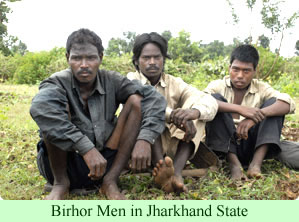Last Friday, 10 Birhor people joined an audience of Indian academics at a two-day conference in the city of Ranchi, in northeastern India, titled “Development and Change in Primitive Tribal Groups of Jharkhand.” The purpose of the conference was to explore ways that the tribal peoples of Jharkhand State might be able to join the economic mainstream of India.
 Rajkumar Birhor, a 60-year old wage laborer from Kewal village in Hazaribagh District in the state told the conference that he wanted employment and education for his children. Another speaker, Vijay Birhor, a 25-year old school dropout, suggested that a source of good water for their village would be helpful. He added that people “don’t get to eat properly in the village.” Forty Birhor families live in Kewal. They are hoping for some state financial assistance.
Rajkumar Birhor, a 60-year old wage laborer from Kewal village in Hazaribagh District in the state told the conference that he wanted employment and education for his children. Another speaker, Vijay Birhor, a 25-year old school dropout, suggested that a source of good water for their village would be helpful. He added that people “don’t get to eat properly in the village.” Forty Birhor families live in Kewal. They are hoping for some state financial assistance.
The conference, organized by the postgraduate anthropology department of Ranchi University, included prominent academics such as Dr. A.A. Khan, the Vice Chancellor of the university, Ajit Kumar Singh, Head of the Post Graduate Department of Anthropology, P.K. Bhowmick, Head of the National Service Scheme at the Indian Institute of Technology, Kharagpur, and many others.
The International Fund for Agricultural Development, a specialized agency of the United Nations that seeks to alleviate rural poverty and hunger in developing countries, is currently assessing the situation. Help may be forthcoming. Vincent Darlong, the Country Office Coordinator, World Food Program, IFAD, said, “we will carry out a detailed project on primitive tribes, which will focus on poverty alleviation.”
Vice Chancellor Khan stressed the importance of preserving the cultural identity of the traditional societies. Prof. Bhowmick said that the term “primitive tribes” should not be used any longer. Mayank Prakas, a scholar, observed that the tribal peoples do not know their rights, a major issue for them. He said that once they learn about available programs, they can achieve food security.
While the academics and administrators were proposing their solutions last weekend, news emerged that a major water crisis has hit Birhor villages in the same district of Jharkhand. Birhor in Doorangarah village report that all sources of water have dried up. Wells, reservoirs, even streams have lost their water due to the failure of the monsoon rains for the second year in a row.
One Birhor youth, trekking to a distant village to obtain water, collapsed and died from dehydration. Three other Birhor from another village, Doorhara, also died due to a lack of water. Local officials have been informed, but the problem for administrators is that the Naxalite Maoist terrorists have a strong presence in the area. As a result, officials have implemented few rural developments such as roads and drinking water. Outsiders dare not visit the area.
Two weeks ago, in the same block of Hazaribagh District, guerillas staged a daring attack on a major road. More than 75 Naxalites stopped three busses, six trucks, and a van, forced 350 people out onto the roadway, and set fire to the vehicles. People who tried to flee were shot at, though no deaths were reported.
The violence lasted for over an hour before the guerillas disappeared into the surrounding forest. A couple hours later, the police finally arrived, promising to launch an investigation.
Since officials, perhaps understandably, do not visit rural areas subject to these kinds of threats, the Birhor have to walk long distances daily, five to eight kilometers in many cases, to obtain water and carry it back to their homes on their heads.
One school in the Naxalite area of the district not only has no water for the students, it now has virtually no students. It has 90 students registered, but recently only 9 were still attending. Due to the lack of water, the school suspended serving a mid-day meal two weeks ago, on March 17, which essentially closed the facility.
It is not clear how much, if any, attention the academics and administrators at the conference in Ranchi paid to the lack of water and the Naxalite terrorism in the Birhor communities.